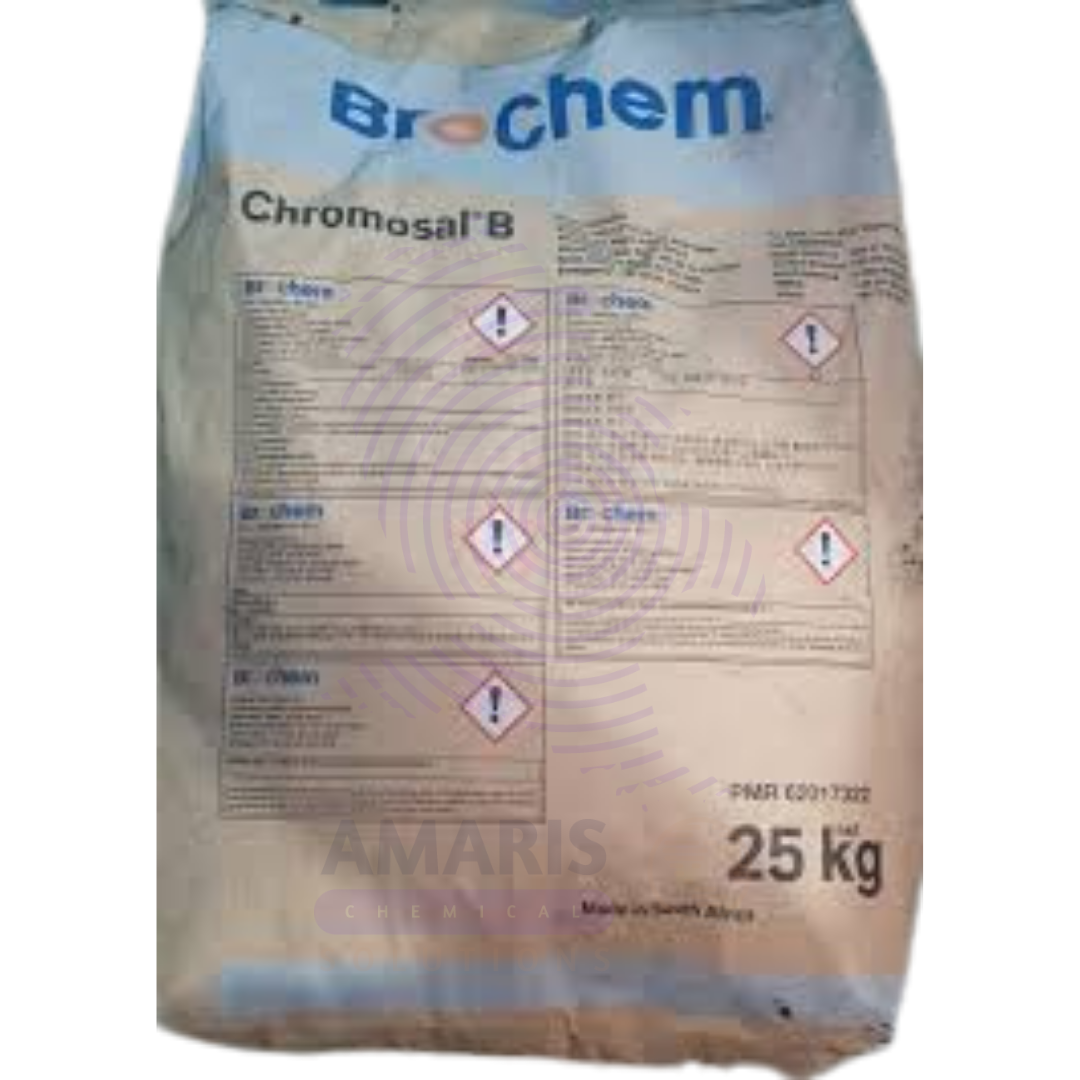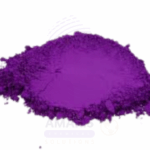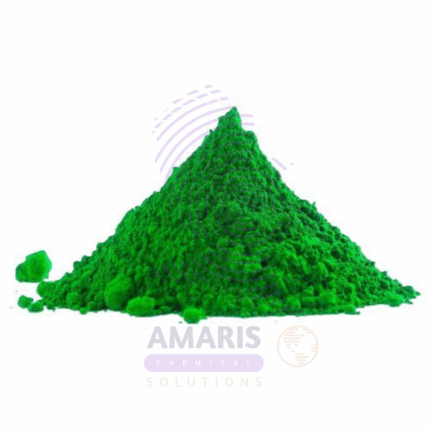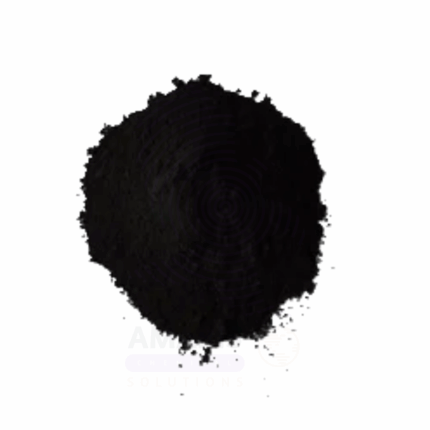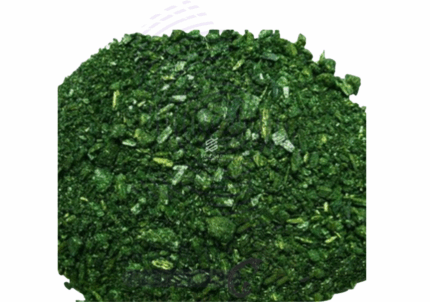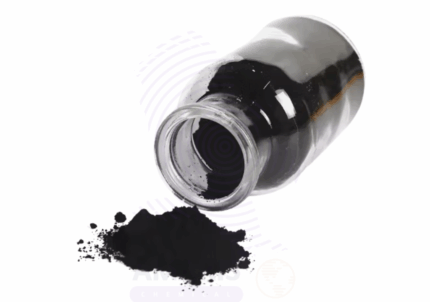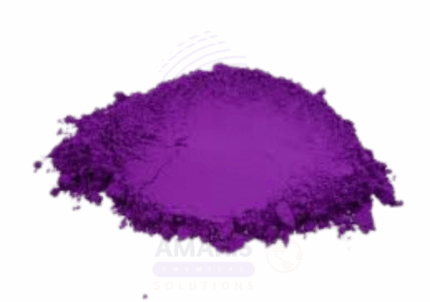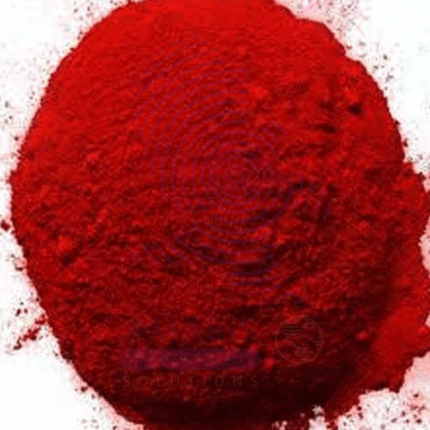Chromosal B
Whatsapp Order
Chromosal B is a specialized chromium-based chemical reagent commonly used in analytical chemistry and laboratory applications. It is typically a chromium salt formulation that serves as a strong oxidizing agent, employed for various testing, purification, and synthesis processes. Chromosal B is valued for its high reactivity, stability in solution, and ability to facilitate oxidative reactions. It is widely used in industrial quality control, chemical synthesis, and wastewater treatment, offering reliable performance in oxidative degradation and metal treatment procedures.
Description
Table of Contents
Toggle
Chromosal B
Primary Uses
- Analytical Chemistry & Laboratory Use
- Used as an oxidizing agent in qualitative and quantitative chemical analysis.
- Employed in redox titrations and sample preparation where strong oxidation is required.
- Applied in the determination of organic and inorganic compounds through oxidative degradation.
- Industrial Applications
- Utilized in wastewater treatment plants to oxidize organic pollutants and heavy metals, aiding in environmental compliance.
- Used in metal surface treatment processes for cleaning and preparation before plating or coating.
- Serves as an intermediate in chemical manufacturing requiring chromium-based oxidizing agents.
Secondary Uses
- Textile Industry
- Applied in dyeing and finishing processes where oxidation is necessary to fix dyes or modify fibers.
- Pharmaceutical Industry
- Used in small-scale organic synthesis of drug intermediates requiring controlled oxidation steps.
- Research and Development
- Employed in experimental oxidation reactions in academic and industrial R&D labs.
KEY PRODUCT FEATURES
1. Basic Identification Attributes
- Chemical Name (IUPAC): Chromium-based oxidizing reagent (specific formula depends on supplier)
- Common/Trade Name: Chromosal B
- CAS Number: Varies depending on chromium salt composition
- HS Code: 2841.90.90 (general chromium compounds)
- Molecular Formula: Variable
- Synonyms: Chromium reagent B, chromium oxidizing agent
2. Physical & Chemical Properties
- Physical State: Typically a crystalline powder or granular solid
- Color & Odor: Dark green to black; odorless
- Melting Point: Variable depending on formulation
- Solubility: Soluble in water forming an acidic solution
- Stability: Stable under dry conditions; reactive in solution as an oxidizer
3. Safety & Hazard Attributes
- Hazard Class (GHS): Corrosive, oxidizer, toxic
- NFPA Ratings: Health 3, Flammability 0, Reactivity 2
- Exposure Limits: OSHA PEL for Chromium VI = 0.005 mg/m³
- Toxicity: Harmful by inhalation, ingestion, and skin contact; carcinogenic potential due to chromium content
- Reactivity: Strong oxidizing agent; reacts violently with reducing agents and organics
4. Storage & Handling Attributes
- Storage Conditions: Store in cool, dry, well-ventilated area away from incompatible substances
- Container Type: Sealed polyethylene or glass containers
- Shelf Life: Stable for years if kept dry and sealed
- Special Handling: Use appropriate PPE including gloves, goggles, and respirator; handle in fume hood
5. Regulatory & Compliance Attributes
- Subject to strict environmental and occupational regulations due to chromium content
- Regulated as hazardous waste; proper disposal required
- Transportation: Classified as hazardous material (oxidizer)
- FDA Status: Not for food or pharmaceutical use
6. Environmental & Health Impact
- Ecotoxicity: Toxic to aquatic organisms; can cause long-term environmental damage
- Persistence: Persistent and bioaccumulative in the environment
- Carcinogenicity/Mutagenicity: Contains Chromium VI, classified as carcinogenic
- Biodegradability: Not biodegradable; requires specialized treatment for disposal
SAFETY HANDLING PRECAUTIONS
Safety Handling Precautions
- PPE: Acid-resistant gloves, eye protection, lab coat, respirator
- Handling: Avoid inhalation and skin contact; use only in well-ventilated areas or fume hoods
- Storage: Keep containers tightly sealed and stored away from incompatible materials
- Hygiene: Wash hands after handling; no eating or drinking in work area
First Aid Measures
- Inhalation: Move to fresh air immediately; administer oxygen if breathing is difficult; seek medical attention
- Skin Contact: Flush with water immediately; remove contaminated clothing; seek medical care if irritation occurs
- Eye Contact: Rinse eyes with water for 15 minutes; seek urgent medical assistance
- Ingestion: Do not induce vomiting; rinse mouth; seek emergency medical attention
Firefighting Measures
- Fire Hazards: Not flammable but a strong oxidizer that can intensify fires
- Extinguishing Media: Use water spray or foam; avoid dry chemical extinguishers that may react
- Special Precautions: Firefighters must wear full protective gear and self-contained breathing apparatus
- Decomposition Products: May release toxic chromium oxides and other harmful gases when heated
Related products
Apple Green Dye
Apple Green Dye is a synthetic or natural colorant that imparts a vibrant, bright green hue resembling the skin of a fresh green apple. It is available in various forms including powders, liquids, and granules, and can be water-soluble or oil-dispersible depending on its chemical base. This dye is widely used across multiple industries including cosmetics, food and beverage, textiles, and industrial applications to achieve consistent and stable green coloration.
It offers excellent light and heat stability, and when formulated correctly, maintains its brightness across a range of pH levels. Apple Green Dye can be derived from certified colorants for safe use in consumables or from synthetic sources for industrial applications.
Black 7 Dye
Black 7 Dye, also known as CI 26150 or D&C Black No. 7, is a synthetic black pigment primarily composed of carbon-based aromatic compounds. It is a high-purity, oil-dispersible colorant derived from oxidized aniline and related intermediates. Known for its intense black shade and strong tinting strength, Black 7 Dye is widely used in the cosmetics, personal care, pharmaceutical, and specialty colorant industries.
This dye is chemically stable, lightfast, and compatible with oils, esters, waxes, and synthetic bases, making it suitable for both leave-on and rinse-off formulations. It is particularly favored in products requiring bold color expression, such as eye makeup, hair dyes, and tattoo inks. Surface-treated forms are also available to enhance dispersibility and formulation compatibility.
Bright Yellow Dye
Bright Yellow Dye is a high-strength, water-soluble synthetic dye solution designed for vibrant red coloration across various industrial and consumer products. With 20% active dye content, it offers excellent color intensity, easy dispersibility, and compatibility with a wide range of aqueous systems. This versatile dye is widely used in textiles, paper, personal care products, and household cleaning formulations.
Phytaloc Yamine green
Phytaloc Yamine Green is a specialized green-colored amine-based chemical used primarily as a corrosion inhibitor and pH stabilizer in various industrial and water treatment applications. It offers excellent protection against metal corrosion and scale formation in cooling systems, boilers, and pipelines. This product is formulated for easy handling and compatibility with diverse chemical environments, making it a versatile additive in process industries.
Printofix Black H-TR
Printofix Black H-TR is a high-quality black textile printing paste designed for use in screen printing applications. It provides excellent color strength, fastness, and adhesion on a variety of fabrics including cotton, polyester, and blended textiles. The formulation ensures sharp, vibrant prints with good wash and rub resistance, making it ideal for industrial and fashion textile printing.
Purple Pigment
Purple Pigment is a colorant formulation containing 10% concentrated purple pigment dispersed in a carrier matrix. It is used to impart purple coloration in a wide range of applications, offering excellent color stability, UV resistance, and compatibility with various substrates. This pigment preparation is widely utilized in plastics, coatings, inks, textiles, cosmetics, and construction materials, where consistent hue and dispersion are essential.
Solvent oil red 24 OSH
Solvent Oil Red 24 OSH is a bright, oil-soluble azo dye used primarily for coloring petroleum-based solvents, oils, waxes, and greases. Known for its excellent solubility in hydrocarbon mediums, this dye delivers a vivid red hue with good thermal stability and moderate lightfastness. Its OSH (Oil Soluble High) formulation ensures optimized dispersion in non-polar systems.
Solvent Oil Red 24 OSH is used in applications requiring visual identification, fuel marking, and product differentiation across industrial environments. It is available in powdered or granulated form and is manufactured to meet industrial-grade quality standards.
Tomato Red Dye
Tomato Red Dye is a synthetic azo dye prized for its vibrant, bright red coloration and excellent water solubility. It delivers consistent, vivid red shades that are stable under a variety of environmental conditions, including exposure to light, heat, and washing. This dye is extensively used across multiple industries including food and beverage, cosmetics, pharmaceuticals, and textiles. In food applications, it enhances the visual appeal of products such as beverages, confectionery, sauces, and baked goods. Its compatibility with different formulation types and regulatory approvals make it a reliable choice for cosmetic products like lipsticks, blushes, and nail polishes, as well as pharmaceutical tablets and syrups for identification and aesthetic purposes. The dye's superior performance, combined with strict adherence to safety and quality standards, ensures that it meets the requirements of manufacturers and regulatory bodies worldwide.


 Preservatives(food)
Preservatives(food) Flavor Enhancers
Flavor Enhancers Acidulants
Acidulants Sweeteners
Sweeteners Antioxidants
Antioxidants Colorants(food)
Colorants(food) Nutraceutical Ingredients (food)
Nutraceutical Ingredients (food) Nutrient Supplements
Nutrient Supplements Emulsifiers
Emulsifiers
 Collectors
Collectors Dust Suppressants
Dust Suppressants Explosives and Blasting Agents
Explosives and Blasting Agents Flocculants and Coagulants
Flocculants and Coagulants Frothers
Frothers Leaching Agents
Leaching Agents pH Modifiers
pH Modifiers Precious Metal Extraction Agents
Precious Metal Extraction Agents
 Antioxidants(plastic)
Antioxidants(plastic) Colorants (Pigments, Dyes)
Colorants (Pigments, Dyes) Fillers and Reinforcements
Fillers and Reinforcements Flame Retardants
Flame Retardants Monomers
Monomers Plasticizers
Plasticizers Polymerization Initiators
Polymerization Initiators Stabilizers (UV, Heat)
Stabilizers (UV, Heat)
 Antifoaming Agents
Antifoaming Agents Chelating Agents
Chelating Agents Coagulants and Flocculants
Coagulants and Flocculants Corrosion Inhibitors
Corrosion Inhibitors Disinfectants and Biocides
Disinfectants and Biocides Oxidizing Agents
Oxidizing Agents pH Adjusters
pH Adjusters Scale Inhibitors( water)
Scale Inhibitors( water)
 Antioxidants(cosmetic)
Antioxidants(cosmetic) Emollients
Emollients Fragrances and Essential Oils
Fragrances and Essential Oils Humectants
Humectants Preservatives
Preservatives Surfactants(cosmetic)
Surfactants(cosmetic) Thickeners
Thickeners UV Filters
UV Filters
 Fertilizers
Fertilizers Soil Conditioners
Soil Conditioners Plant Growth Regulators
Plant Growth Regulators Animal Feed Additives
Animal Feed Additives Biostimulants
Biostimulants Pesticides (Herbicides, Insecticides, Fungicides)
Pesticides (Herbicides, Insecticides, Fungicides)
 Active Pharmaceutical Ingredients (APIs)
Active Pharmaceutical Ingredients (APIs) Excipients
Excipients Solvents(pharmaceutical)
Solvents(pharmaceutical) Antibiotics
Antibiotics Antiseptics and Disinfectants
Antiseptics and Disinfectants Vaccine Adjuvants
Vaccine Adjuvants Nutraceutical Ingredients (pharmaceutical)
Nutraceutical Ingredients (pharmaceutical) Analgesics & Antipyretics
Analgesics & Antipyretics
 Analytical Reagents
Analytical Reagents Solvents(lab)
Solvents(lab) Chromatography Chemicals
Chromatography Chemicals Spectroscopy Reagents
Spectroscopy Reagents microbiology-and-cell-culture-reagents
microbiology-and-cell-culture-reagents Molecular Biology Reagents
Molecular Biology Reagents Biochemical Reagents
Biochemical Reagents Inorganic and Organic Standards
Inorganic and Organic Standards Laboratory Safety Chemicals
Laboratory Safety Chemicals Specialty Laboratory Chemicals(Special Laboratory Equipment)
Specialty Laboratory Chemicals(Special Laboratory Equipment)
 Demulsifiers
Demulsifiers Hydraulic Fracturing Fluids
Hydraulic Fracturing Fluids Scale Inhibitors(oil)
Scale Inhibitors(oil) Surfactants(oil)
Surfactants(oil) Drilling Fluids
Drilling Fluids
 Dyes and Pigments
Dyes and Pigments Bleaching Agents
Bleaching Agents Softening Agents
Softening Agents Finishing Agents
Finishing Agents Antistatic Agents
Antistatic Agents
 Admixtures
Admixtures Waterproofing Agents
Waterproofing Agents Sealants and Adhesives
Sealants and Adhesives Curing Compounds
Curing Compounds Concrete Repair Chemicals
Concrete Repair Chemicals Anti-Corrosion Coatings
Anti-Corrosion Coatings
 Surfactants(cleaning)
Surfactants(cleaning) Builders
Builders Enzymes
Enzymes Solvents (Cleaning)
Solvents (Cleaning) Fragrances
Fragrances
 Electronic Chemicals
Electronic Chemicals Catalysts
Catalysts Lubricants
Lubricants Photographic Chemicals
Photographic Chemicals Refrigerants
Refrigerants Automotive chemicals
Automotive chemicals Pyrotechnic Chemicals
Pyrotechnic Chemicals
 Biodegradable Surfactants
Biodegradable Surfactants Bio-based Solvents
Bio-based Solvents Renewable Polymers
Renewable Polymers Carbon Capture Chemicals
Carbon Capture Chemicals Wastewater Treatment Chemicals
Wastewater Treatment Chemicals
 Pigments
Pigments Solvents(paint)
Solvents(paint) Specialty Coatings
Specialty Coatings Binders/Resins
Binders/Resins Additives
Additives Driers
Driers Anti-Corrosion Agents
Anti-Corrosion Agents Functional Coatings
Functional Coatings Application-Specific Coatings
Application-Specific Coatings
 Fresh Herbs
Fresh Herbs Ground Spices
Ground Spices Whole Spices
Whole Spices Spice Blends
Spice Blends Dried Herbs
Dried Herbs
 Leavening Agents
Leavening Agents Dough Conditioners
Dough Conditioners Flour Treatments
Flour Treatments Fat Replacers
Fat Replacers Decoratives
Decoratives Preservatives(baking)
Preservatives(baking)
 Plasticizers & Softeners
Plasticizers & Softeners Reinforcing Agents
Reinforcing Agents Adhesion Promoters
Adhesion Promoters Vulcanizing Agents
Vulcanizing Agents Antidegradants
Antidegradants Blowing Agents
Blowing Agents Fillers & Extenders
Fillers & Extenders Accelerators & Retarders
Accelerators & Retarders